The week at a glance
- Pacific Divers in Pembrokeshire and Scilly
- Great Spotted Cuckoo in County Cork
- Possible Steller's Eider in County Kerry
After all that cold weather and snow-induced misery, this week saw a return to rather milder and more hospitable conditions, with temperatures edging up towards double figures and the sun popping out from time to time for good measure.
A little like Punxsutawney Phil, the true hero of Groundhog Day, the birders of Pembrokeshire are blessed with their own megastar popping up every winter to announce his (or her) presence as the season heads slowly but surely towards springtime. Yes, as it's February, it must be time for the (now fully adult) Pacific Diver to make an appearance at Llys-y-fran Reservoir. The 2009 showing seems to have been the briefest so far of the bird's three consecutive winter visits: it was seen in the fading light of 15th and seen well by three local birders early on the morning of 16th but, despite subsequent searches, the quarry seems to have gone to ground. Interestingly, the bird was already moulting into summer plumage — black on the chin and throat, some white on the scapulars and some flecks of grey coming through on the crown and hindneck — so anyone chancing upon a moulting "Black-throated"-type diver in the next few days should be extra careful in their identification. Over on Scilly, the island's first record of Pacific Diver was firmed up this week: starting as a distant possible on 16th (between Pelistry on St. Mary's and the Eastern Isles) the adult bird became a probable by the morning of 17th (when it was off the north end of St. Mary's). By the close of play on the same day it was a confirmed record, lingering on the sea, again between Pelistry and the Eastern Isles, where it remained to 18th. This follows on from the report of a "possible adult" off St. Mary's on 22nd December last year. Rather more summery, and utterly unexpected, was the adult Great Spotted Cuckoo found at Ringaskiddy (Co. Cork) on the afternoon of 15th. This is the first record in the Republic since a first-summer bird at Carnsore Point (Co. Wexford) in April 2002 and would be the sixth record for Ireland (five for the south, one for the north, but of these, one dates from March 1842, and another from "early spring" 1918). This particular species is known as an early overshooting vagrant, more often in March or April, but February records are already on the books for Guernsey in 1950 (on 18th), Alderney in 1982 (on 14th), Lundy (Devon) in 1990 (on 23rd) and, also in Devon, at Dawlish Warren in 1998 (on 22nd). Following on from the shenanigans of the Welsh hoax, a possible Steller's Eider in County Kerry would have proved popular if it had moved in closer inshore off Castlegregory on 15th. Seen by a known (and respected) observer this time, some significant features were noted, but the bird was apparently too far away for the red alert call.
With all the interest in divers, it was nice to see a couple of White-billed Divers also making the news this week. An early arrival to the regular spring passage hotspot of Port Skigersta, Lewis (Outer Hebrides) was seen on 12th and was followed by one still in Bluemill Sound (Shetland) on 15th. A single Pomarine Skua was seen off the Suffolk coast on 16th while four Little Auks were off St. Ives Island (Cornwall) on 12th, with one off St. Mary's (Scilly) on 18th.
The Cattle Egret remained on Scilly throughout the week, while in Cornwall singles were seen at Sennen, Polzeath and Pendeen, with two still around the Gannel Estuary on 16th. Three Cattle Egrets were still on the Exe Estuary at Powderham (Devon) to 17th and a second trio were at Bicton Park from 14th–16th. Further east in the county a single bird was still at Seaton at the start of the week and in north Devon, a Cattle Egret was seen at Yelland on 16th–18th. At least one bird was still being seen at Shapwick Heath (Somerset) on 15th and the same date saw a Cattle Egret arrive at Port Erin (Isle of Man), where it remained to 18th. In Norfolk, last week's bird was still present near Matlaske throughout the week. In County Cork, five birds were noted at Caherlarhig on 16th, four were at Rossleague on 12th and three were at Cobh on 15th. Elsewhere in the county, single Cattle Egrets were at Lough Beg, near Cork Harbour and Great Island. Two birds were at Drumlohan (Co. Waterford) on Valentine's Day.
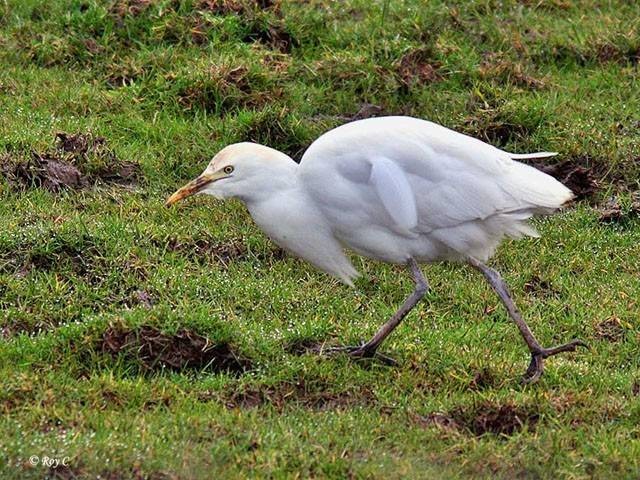
Cattle Egret, Yelland, Devon (Photo: Roy Churchill)
Travelling by train seemed to be a great way to see Great White Egrets if you were birding in Cambridgeshire this week. On 13th one was seen from on board a train near Prickwillow and on 15th and 18th train-travelling birders saw one close to Ely station. On 13th, single birds were still being seen at Shapwick Heath (Somerset) and Hilton (Derbyshire) and on 16th Great White Egret records in Suffolk came from Needham Market and Somerleyton. A couple of reports from Leicestershire during the week seemed to remain unproven. The six Spoonbills in north Devon had a little change of scene this week, popping up at Wrafton on 12th (three were at Isley Marsh on 17th). Other Devon birds this week were at Bishopsteignton and Powderham (singles only) and two were still around Ernesettle to 14th (popping across to Cornwall the following day). Elsewhere the lone bird remained around Samson (Scilly) to 13th, four or five birds were around Poole Harbour (Dorset) in midweek, with another at Lodmoor on 17th–18th. The week's regular Common Cranes included ten in Broadland, near Waxham on 18th, and two at Lakenheath (Suffolk) throughout the week.
The adult Red-breasted Goose that spent so much of its winter time in Hampshire shifted a little further along the coast this week, popping up at East Head (West Sussex) on 12th–16th and moving to West Wittering on 17th–18th. Caerlaverock in Dumfries and Galloway hosted a Taverner's Canada Goose and a Cackling Canada Goose on consecutive days this week (15th and 16th) and two vagrant Canada Geese were seen again at the North Slob (Co. Wexford) on 17th. The Norfolk Ross's Goose went missing for a few days this week before appearing at Hillington (east of King's Lynn) on 17th–18th, while Snow Geese included the bird in Ayrshire (at Drongan) from 13th–18th, in Argyll (at Craobh Haven) on 14th when single birds were seen in Ireland, on the North Slob and also in County Mayo, on the Mullet. The latter two locations also held single Black Brants this week, with others on the Exe Estuary (Devon), Sturt Pond and Farlington Marshes (Hampshire), Pagham Harbour and Fishbourne (West Sussex) and Titchwell, Wells and Morston (Norfolk).
The drake Lesser Scaup was still at Holme Pierrepont (Nottinghamshire) to 14th with the same date seeing two birds noted in Ireland: a drake was at Lough Sheelin (Co. Cavan) and the female was again seen at Clea Lakes (Co. Down). The female Ring-necked Duck remained on North Ronaldsay (Orkney) to 13th and the female at Martnaham Loch (Ayrshire) was still present to 16th. In County Wicklow, two females were on Vartry Reservoir on 18th. Drakes this week were at Foxcote Reservoir (Buckinghamshire), Ballyallia Lake (Co. Clare) and Carrowmore Lake (Co. Mayo). In Norfolk, a "private site" near Horning boasted a female Ring-necked Duck and drake Ferruginous Duck on 15th. More accessible Ferruginous Ducks were at Old Hall Marshes (Essex) on 14th–17th and at Oxford Island (Co. Antrim) on 15th. At least 13 drake Green-winged Teals were reported during the week, eight in England, four in Scotland and one in Ireland. Of note were the birds found at Bothal Pond (Northumberland) on 14th (remaining to 16th), Radwell GPs (Bedfordshire) and Gilston (Moray) on 15th and Wet Moor (Somerset) on 16th. The drake American Wigeon was still around Wick (Highland) to 13th, while down in Fife a drake Surf Scoter was off Ruddon's Point all week, with just one female reported, off Dawlish Warren (Devon). Back in Fife, the second-winter male King Eider was still around Kincraig Point to the end of the week, while the pair near Lissadell (Co. Sligo) remained to 15th at least. In Kent, a drake King Eider made a surprise reappearance off the coast at Lydd on 14th–15th — assuming it is one and the same, the bird was last seen flying west past Dungeness on 20th January. Where's it been between times? No problem knowing where to find the Dorset drake Hooded Merganser — the breadcrumbs around the bridge at Radipole Lake are a tell-tale sign that the boy is still in residence, and still regarded as dubious by most.
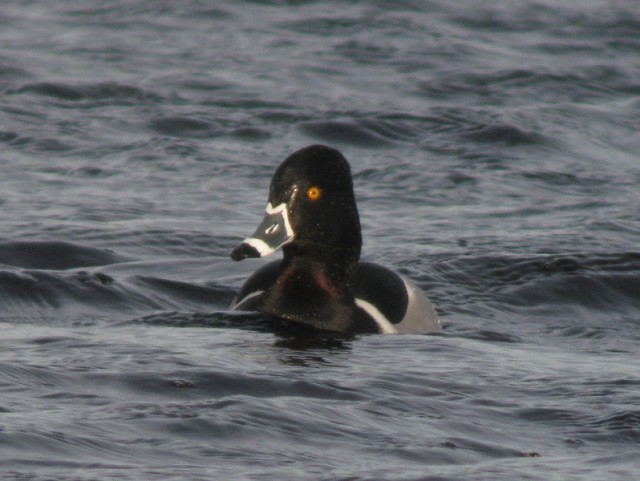
Ring-necked Duck, Carrowmore Lake, Mayo (Photo: Dermot Breen)
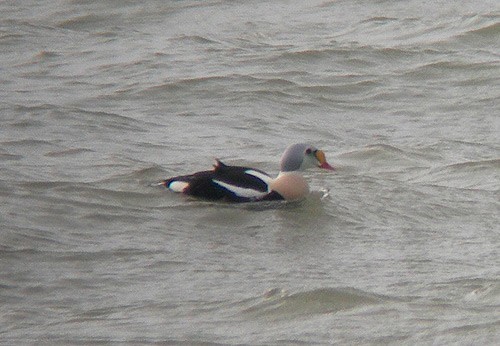
King Eider, Dungeness, Kent (Photo: Marc Heath)
In Suffolk, the Lesser Yellowlegs was still around Walberswick between 12th and 16th and appeared to be the only shorebird of any note this week.
The White-tailed Eagle in Dumfries & Galloway was still around Kirkcudbright, flying over Cumstoun on 16th — this bird is known to originate from a reintroduction scheme in Fife. In Wales, a white-morph Gyrfalcon was seen again in Pembrokeshire on 17th, flying over the Gann Estuary towards Marloes (a Gyr was last seen in the county on 2nd of this month). Alongside the familiar wintering Rough-legged Buzzards in Kent (with two at Harty Marshes on 18th) and Lincolnshire, "new" birds were seen at Plenmeller Common (Northumberland) on 13th, Sandringham (Norfolk) on 14th (luckily no young Royals were out on the estate that day) and Lagness (West Sussex) on 16th. A second-winter male Rough-legged Buzzard was seen flying southeast over Combe Hill (Berkshire) on 14th with a bird of the same age and sex then taking up residence at Faccombe (Hampshire) the following day, to the week's end. Could it be that the second-winter males seen in Hertfordshire, Cambridgeshire and now Berkshire and Hampshire are, in fact, the same bird full stop?
In Devon, a first-winter American Herring Gull was seen at Budleigh Salterton on the afternoon of 13th, but further searches proved fruitless. Numbers of Caspian Gulls fell away to only 20 or so this week, with three first-winters at Pitsea (Essex) on 14th, two more first-winters at Sandbach Flashes (Cheshire) on the same date, while three birds in Suffolk were also of particular note. Iceland Gulls reached nearly 90 birds (from at least 53 counties) in Britain this week, while Ireland scored at least 55 birds from just nine counties, helped by the big scores of 20 at Killybegs (Co. Donegal) on 15th and 12 at Nimmo's Pier (Co. Galway) on 14th. Both sites (perhaps unsurprisingly) also held Kumlien's Gulls this week: an adult at the former site on 15th and an adult and second-winter at the latter site on 14th. Also in County Galway on 14th, a third-winter was again at Clifden. Juvenile Kumlien's Gulls remained on St. Mary's (Scilly), at Forfar Loch and Kirriemuir (Angus) and at Stornoway, Lewis (Outer Hebrides). Glaucous Gulls too managed comfortably to keep numbers in three figures this week with a split of almost 80 birds in Britain and just over 50 in Ireland. On the Gualan spit, South Uist (Outer Hebrides), at least 12 birds remained to 13th, while on Tiree (Argyll), perhaps as many as 13 birds were noted around the island during the week (with two dead birds as well). Killybegs' haul was 13 on 15th, while on the Mullet (Co. Mayo) 15 birds were seen on 14th. Ring-billed Gulls this week included regular adults in Hampshire, London, Essex and Angus, the second-winter in Glamorgan and the first-winter in Cornwall, at Helston. An adult was seen again in Cheshire, at Richmond Bank on 14th and Moore NR on 16th, and an adult was at Lamby Lake on 14th (the third bird at the site this winter). Another Welsh adult was at Llys-y-fran Reservoir (Pembrokeshire) on 17th–18th. In Ireland, at least 13 birds were seen this week, including four adults at Nimmo's Pier on 14th and three at Cuskinny Marsh (Co. Cork) on 12th.

Iceland Gull, Killybegs, Donegal (Photo: Derek Charles)

Glaucous Gull, Cley next the Sea, Norfolk (Photo: Anthony Griffiths)

Kumlien's Gull, Killybegs, Donegal (Photo: Derek Charles)
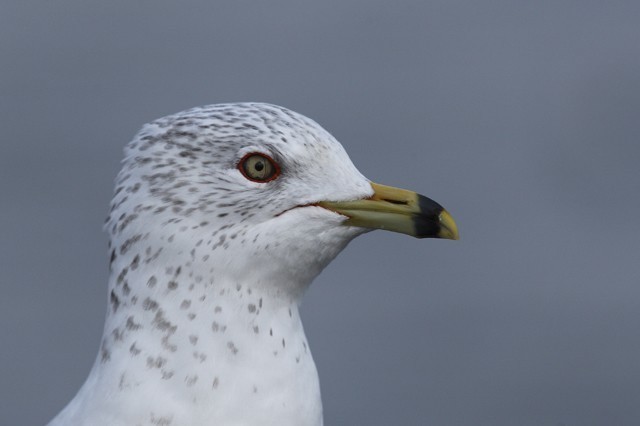
Ring-billed Gull, Nimmo's Pier, Galway (Photo: Sean Browne)
The first-winter male Snowy Owl remained in west Cornwall this week, still enjoying the hillsides around Amalveor Downs from 15th–18th. In Norfolk, the Dark-breasted Barn Owl remained at Welney to 14th and a "brown-bodied" bird was at Howden's Pullover (Lincolnshire) on 15th. Back in Norfolk, the popular first-winter Black-bellied Dipper continued to move along the River Glaven throughout the week, often popping up around Letheringsett. It was a tricky week in which to gauge just how many Great Grey Shrikes have been noted — it could be as many as 18 birds. Up to three were noted in both Hampshire and Norfolk, while Suffolk, East Sussex, Gloucestershire and Oxfordshire could have laid claim to at least two apiece. Notable singles were on Bellever Tor (Devon) on 15th–17th and at Chameberlayne's Heath (Dorset) on 12th–15th.

Black-bellied Dipper, Letheringsett, Norfolk (Photo: John Miller)
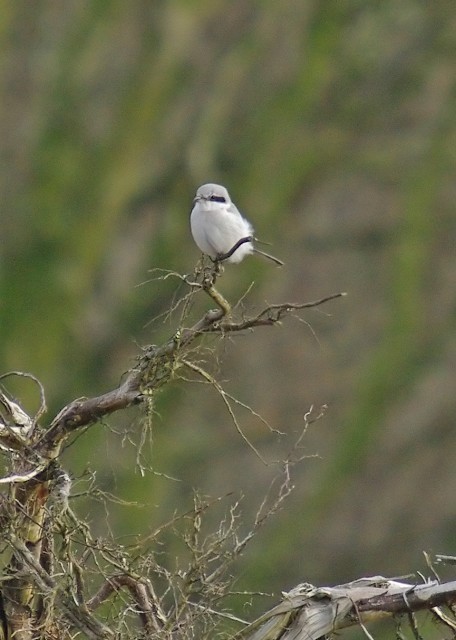
Great Grey Shrike, Bellever Tor, Devon (Photo: Charlie Fleming)
Waxwings this week included an impressive flock of 380+ in Sheffield (South Yorkshire) on 16th and 220+ in Selston (Nottinghamshire) and 230+ in Stoke-on-Trent (Staffordshire) on 15th.

Waxwing, Stafford, Staffs (Photo: S Petrek)
Siberian Chiffchaffs (or birds resembling this teasing form) were still being seen in Berkshire, Devon (two sites) and Dorset, with two still at Lodmoor RSPB on 15th. A Lesser Whitethroat in a garden in Newlyn (Cornwall) on 16th was thought to be a probable halimodendri — a Central Asian form and, as many see it, an unlikely split.

Siberian Chiffchaff, Lodmoor RSPB, Dorset (Photo: Rob Laughton)
In Devon, the male Penduline Tit at Clennon Valley, Paignton was present to midday on 15th, then took a little trip to nearby Paignton for the rest of the day and 16th too, before heading back to Clennon to the end of the week. In Norfolk, at Strumpshaw Fen, the elusive male was seen again on 14th and 16th, with two birds seen on the latter date, with one still present on 17th.
Photo of the Week

Sparrowhawk, Stainland, W Yorks (Photo: Sean Gray)
We at BirdGuides admit to a fascination with bird predation and have featured a number of images depicting "nature in the raw". For anyone who tends to find such images disturbing, but who still appreciates the power and majesty of birds of prey in action, this week's Photo of the Week is the perfect action shot. Sean Gray's pin-sharp portrait of a Sparrowhawk astride its prey emphasises the lean muscularity of the hawk, whilst obscuring any detail in its unfortunate victim (we won't even mention the words 'Collared Dove'). The bird's brilliant yellow eye and bold breast markings stand out against the sombre hues of the setting.

Brambling, Forest of Dean, Glos (Photo: Lewis Thomson)

Fieldfare, Hackthorn, Lincs (Photo: Dean Eades)

Barn Owl, East Walton, Norfolk (Photo: Stephen Durrant)

Short-eared Owl, undisclosed site, S Yorks (Photo: Rob Smith)

White-tailed Eagle, undisclosed site, Argyll (Photo: Ian Cook)

Snow Bunting, Salthouse, Norfolk (Photo: Nigel Pye)

Waxwing, Witham St. Hughs, Lincs (Photo: Dean Eades)

Kea, New Zealand (Photo: Craig Nash)

Splendid Sunbird, Gambia (Photo: Kit Day)

White Stork, Spain (Photo: Steve Fletcher)

Pheasant, Wiveton, Norfolk (Photo: Richard Bedford)

Golden Plover, Dinham Flats, Cornwall (Photo: Colin Selway)

Siskin, Llandrindod Wells, Powys (Photo: Kev Joynes)

Brent Goose, Cley Marshes NWT, Norfolk (Photo: Amanda Hayes)

